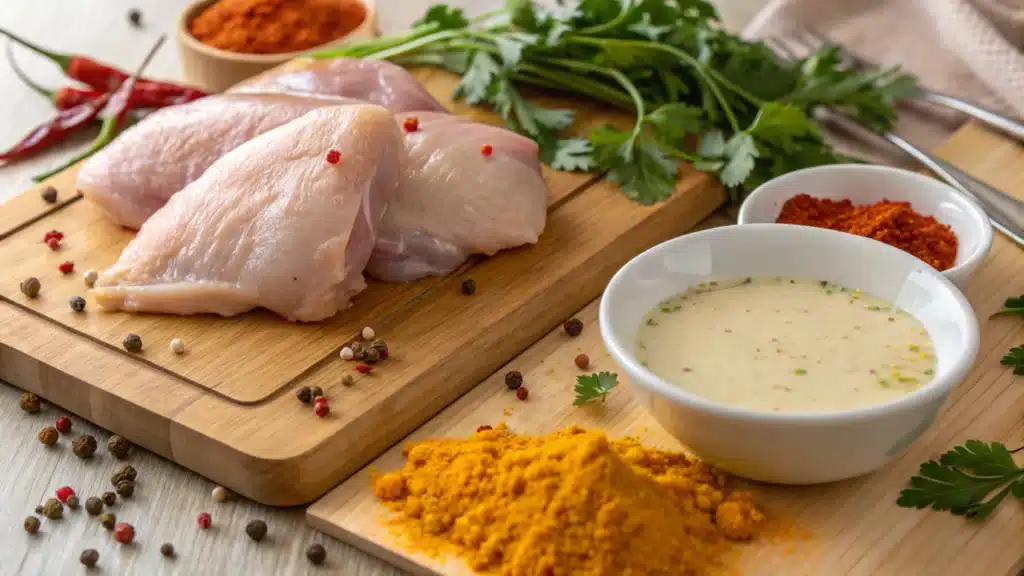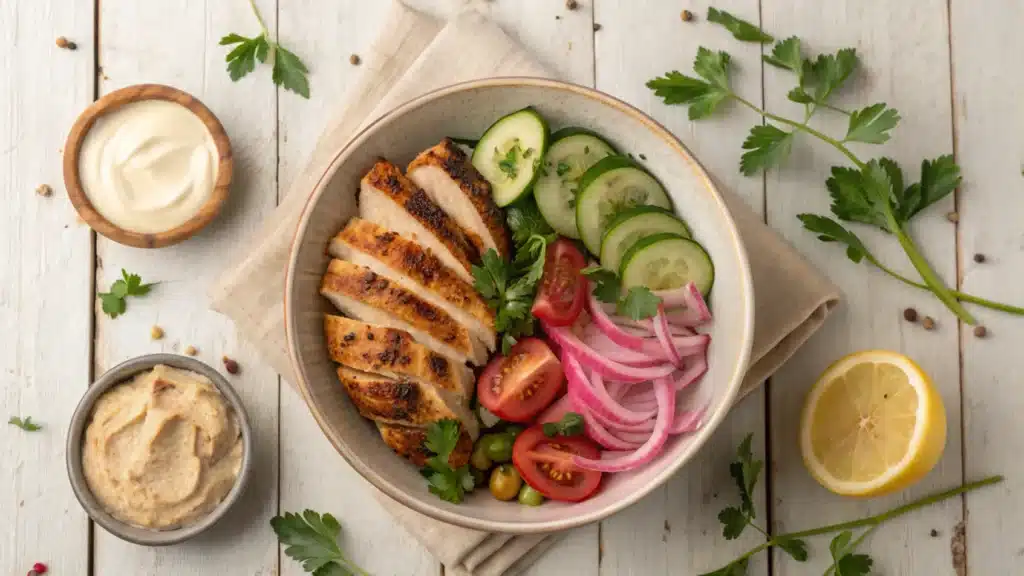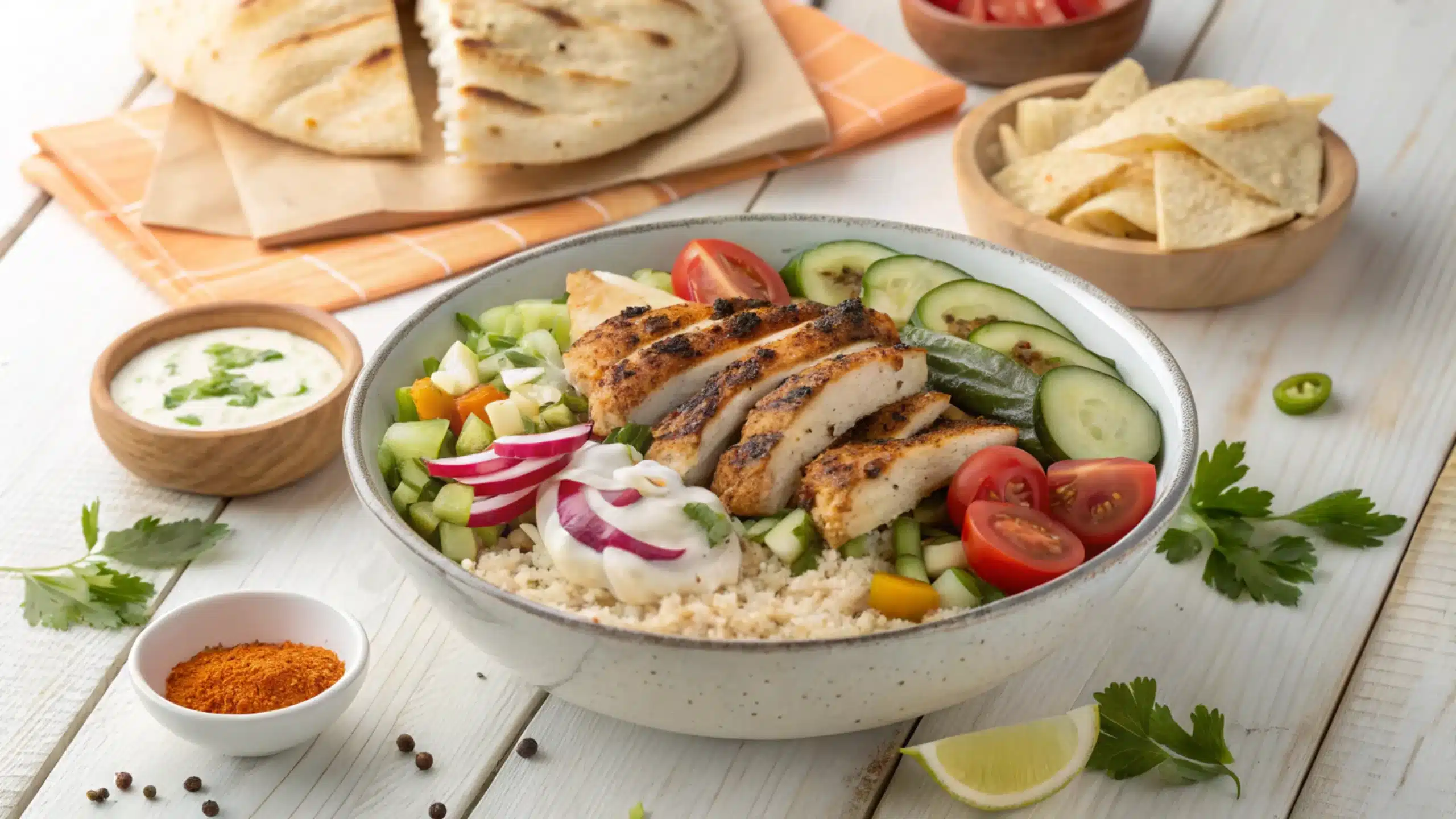Origins and Cultural Significance of Chicken shawarma bowl
The chicken shawarma bowl traces its origins back to the Middle East, specifically to the Ottoman Empire. Traditionally, it was prepared using spit-roasting techniques, which became a widely popular cooking style throughout the region. Moreover, the dish symbolizes community and shared meals, making it a beloved choice often enjoyed as street food. Vendors typically slice and serve shawarma fresh from the spit, thereby offering diners a quick yet flavorful option.
How Shawarma Has Evolved Globally
Over time, shawarma has traveled beyond its origins, evolving to fit different global cuisines. Western adaptations include shawarma tacos, wraps, and the modern chicken shawarma bowl. Fusion recipes often incorporate local ingredients and spices, creating new and exciting flavors. Despite these changes, shawarma maintains its essence of marinated, slow-cooked meat.
What Defines Chicken Shawarma Bowl?
Shawarma is recognized for its stacked layers of marinated meat cooked on a vertical rotisserie. The slow rotation ensures even cooking, producing tender slices with crispy edges. Cooks shave off the outer layers as they cook, ensuring each serving is fresh and flavorful.
Why Chicken Shawarma Bowl Is a Cornerstone of Middle Eastern Cuisine
Shawarma highlights the Middle East’s love for bold spices, aromatic marinades, and communal eating. It blends simple ingredients with rich flavors, showcasing the region’s culinary expertise. Whether served in wraps, on platters, or as a chicken shawarma bowl, shawarma remains a versatile and beloved dish.
Key Ingredients of Chicken Shawarma Bowl

The Meat
Shawarma begins with carefully selected meat, often the heart of the dish. Traditionally, lamb, chicken, beef, or turkey are used. Chicken, especially in the chicken shawarma bowl, is a popular choice for its tender texture and ability to absorb marinades. Slicing the meat thinly and stacking it on a vertical rotisserie ensures even cooking, creating juicy layers with caramelized edges. While lamb and beef are common in some regions, turkey offers a lighter option.
Explore this guide to diced chicken recipes to discover more ways to prepare tender, flavorful chicken for your dishes.
The Marinade
Shawarma’s flavor comes from its bold marinade. Spices such as cumin, coriander, paprika, turmeric, and garlic powder create a smoky and warm profile. Yogurt and lemon juice add tanginess while tenderizing the meat. Olive oil locks in moisture, keeping the meat succulent. Allowing the marinade to infuse for several hours, or even overnight, ensures deeper flavor.
The Cooking Method
Shawarma is traditionally cooked on a vertical spit, where the slow rotation ensures even heat distribution. As the outer layers brown, cooks shave them off for serving. For home preparation, grilling or roasting offers a practical alternative. Although the flavor may differ slightly, proper marination and careful cooking replicate the authentic technique.
The Wrap or Bowl
Shawarma is often served in pita bread for a portable and filling meal. However, modern variations like the chicken shawarma bowl replace bread with grains like rice or quinoa or greens for a gluten-free alternative. Adding toppings such as pickled vegetables and sauces elevates the dish, making it both versatile and visually appealing.
Variations of Chicken Shawarma Bowl Across Cultures
Middle Eastern Chicken shawarma bowl
In its birthplace, shawarma carries deep cultural meaning and remains a key symbol of Middle Eastern food. For example, Lebanese and Syrian versions often use chicken or lamb, spiced heavily and served with garlic sauce, pickled turnips, and tabbouleh for a rich, balanced taste. In contrast, Israeli shawarma commonly uses turkey and adds amba, a tangy mango sauce that gives the dish a unique and flavorful twist.
Global Adaptations
As shawarma became popular around the world, it easily adapted to local flavors. For example, in the U.S., dishes like the chicken shawarma bowl mix traditional spices with a focus on quick and healthy meals. In addition, fusion dishes like shawarma tacos and pizzas show how chefs creatively use Middle Eastern spices in fresh and fun ways.
For a creative twist, try our recipe for shawarma-inspired grilled chicken nuggets, which combine classic flavors with simple and modern cooking methods.
Vegetarian and Vegan Shawarma
Vegetarian and vegan options replicate shawarma’s bold flavors while avoiding meat. Falafel, jackfruit, or tofu marinated with traditional spices offer similar textures and tastes. These plant-based versions often include traditional toppings and sauces, ensuring they remain true to shawarma’s spirit.
Accompaniments and Toppings for Chicken shawarma bowl
Fresh Toppings
Crisp cucumbers, juicy tomatoes, and thinly sliced onions not only add refreshing elements but also help balance the richness of the meat. In addition, fresh herbs such as parsley or mint further enhance both the flavor and the presentation, making each bite more vibrant and enjoyable. If you’re looking for more ideas on incorporating fresh ingredients, be sure to explore our healthy breakfast burrito guide, which focuses on nutrient-rich toppings and flavorful sauces.
Pickled Additions
Pickled turnips and jalapeños are staples of shawarma, offering tangy and spicy contrasts to the savory meat. These elements create a harmonious balance of flavors.

Signature Sauces
Garlic sauce (toum) provides a creamy, garlicky kick, while tahini adds nutty richness. For those who enjoy heat, spicy harissa or chili-based sauces elevate the dish. These sauces tie together the flavors in a wrap or a chicken shawarma bowl, creating a satisfying meal.
Health Aspects of Chicken shawarma bowl
Nutritional Profile of Chicken shawarma bowl
Chicken shawarma bowl combines high-protein meat with nutrient-rich toppings, offering a balanced meal. For example, a chicken shawarma bowl includes lean protein, fresh vegetables, and fiber from grains, making it a healthy choice.
Healthier Shawarma Options
To make shawarma healthier, opt for lean meats like chicken or turkey. Use whole-grain wraps or serve the dish over greens to reduce carbs. Low-fat yogurt-based sauces can also lower calorie counts without sacrificing flavor.
If you’re looking for more nutritious meal options, try our recipe for chicken broccoli alfredo casserole to balance bold flavors with wholesome ingredients
Vegan and Gluten-Free Adjustments
For vegans, jackfruit or chickpeas are great substitutes for meat. Gluten-free diners can replace pita with rice, quinoa, or mixed greens to enjoy a bowl version of shawarma.
Comparing Chicken shawarma bowl to Similar Dishes
What Are the Two Types of Shawarma?
Shawarma mainly comes in two types: chicken and beef or lamb. For example, chicken shawarma, often served in the well-loved chicken shawarma bowl, is lighter and goes well with fresh toppings like cucumbers and tomatoes. In contrast, beef or lamb shawarma has a richer taste, boosted by stronger spices, making it a great choice for those who prefer heavier, more filling meals.
Is Chicken Shawarma the Same as Gyros?
Although similar in appearance, shawarma and gyros differ in spices and preparation. Shawarma uses bold Middle Eastern spices, while gyros feature Mediterranean seasonings like oregano. Shawarma often includes tahini, whereas gyros are served with tzatziki.
FAQs About Chicken Shawarma Bowl
What Do You Eat Chicken Shawarma With?
Chicken shawarma is a versatile dish that goes well with many sides, drinks, and desserts. For example, fluffy pita bread is perfect for wrapping the juicy meat and sauces, making it easy to eat. If you prefer something hearty, basmati rice or quinoa can serve as a delicious base. Fresh salads, like tabbouleh or a mix of cucumbers and tomatoes, add a refreshing touch and balance the rich flavors.
Additionally, creamy dips such as hummus or baba ghanoush pair wonderfully with shawarma, adding smooth textures to the meal. Pickled vegetables like turnips and cucumbers provide a tangy contrast that enhances the bold spices of the meat.
For drinks, mint lemonade is a popular choice as it cools the palate, while laban (a yogurt-based drink) complements the dish’s savory flavors. Finally, desserts like baklava or a light rosewater pudding are great options to finish the meal on a sweet note.
What Is a Shawarma Made Of?
Shawarma is made with thinly sliced meat, often chicken, beef, lamb, or turkey, that is marinated in flavorful spices. These spices usually include cumin, turmeric, paprika, and coriander, which give the dish its bold and smoky taste. The marinade also contains yogurt and lemon juice, which help tenderize the meat and enhance its flavor.
The meat is stacked in layers on a vertical spit and cooked slowly as the spit rotates. This method creates meat that is juicy on the inside and slightly crispy on the outside. Shawarma is often served in pita bread, bowls, or platters and paired with toppings like fresh vegetables and sauces such as garlic toum or tahini.
What Are the 2 Types of Shawarma?
Shawarma typically comes in two main types based on the kind of meat used: chicken and beef or lamb. Chicken shawarma is lighter and works well in dishes like the chicken shawarma bowl, where it pairs beautifully with grains, fresh vegetables, and creamy sauces. Its mild flavor allows the spices in the marinade to stand out.
In contrast, beef or lamb shawarma has a deeper, richer taste. These meats are often marinated with stronger spices like cinnamon or allspice to enhance their bold flavors. Both types are versatile and can be served in wraps, bowls, or on a platter, depending on your preference.
Is Chicken Shawarma the Same as Gyros?
Although chicken shawarma and gyros may look alike, they have key differences in origin, spices, and preparation. Shawarma comes from the Middle East, while gyros are a traditional Greek dish. Shawarma is seasoned with bold Middle Eastern spices like turmeric and cumin, while gyros use simpler Mediterranean flavors such as oregano and garlic.
Additionally, the cooking style differs slightly. Shawarma is cooked on a vertical spit with thinly layered meat, while gyros are often made with thicker cuts of meat stacked on a similar spit. The toppings also vary shawarma is usually served with tahini or garlic sauce and pickled vegetables, while gyros come with tzatziki, tomatoes, and onions.
Why Chicken shawarma bowl Is Loved Globally
Summary of Key Takeaways
Shawarma’s unique combination of bold spices, tender slow-cooked meats, and versatile serving options has undoubtedly made it a global favorite. Whether you enjoy it wrapped in pita bread, served alongside flavorful sides, or transformed into a modern twist like the chicken shawarma bowl, shawarma truly offers something for everyone. Moreover, its rich cultural history, combined with its ability to adapt to contemporary tastes, further highlights its lasting appeal.
In addition, the dish not only reflects the culinary traditions of the Middle East but also showcases the art of fusion by blending classic flavors with creative twists. Furthermore, its accessibility as a street food, coupled with its adaptability in home kitchens, makes it one of the most versatile and widely enjoyed dishes across the globe.
Encouragement to Experiment
One of the great joys of shawarma lies in its adaptability. Home cooks can explore endless possibilities by experimenting with different proteins, marinades, and toppings. For example, you can try pairing it with garlic butter chicken strips or draw inspiration from the chicken broccoli alfredo casserole to balance bold flavors with healthy choices.
Whether you’re crafting a traditional recipe or a modern variation, shawarma guarantees satisfaction with its rich, flavorful profile. So why not start experimenting today? With its balance of spices, textures, and vibrant accompaniments, shawarma is more than a dish it’s an experience to savor and share.

Chicken Shawarma Bowl
Ingredients
Equipment
Method
- In a large bowl, whisk together olive oil, yogurt, lemon juice, garlic, and spices. Add chicken and coat well. Cover and marinate for at least 2 hours or overnight.
- Preheat grill or oven to 400°F (200°C). Grill or roast chicken for 25–30 minutes, until cooked through and slightly charred at the edges.
- Let chicken rest for 5 minutes, then slice thinly.
- Assemble bowls: Divide rice among serving bowls. Top with chicken, cucumber, tomatoes, pickled turnips, onions, and parsley.
- Drizzle with garlic sauce and tahini before serving.

1 thought on “Chicken Shawarma Bowl”